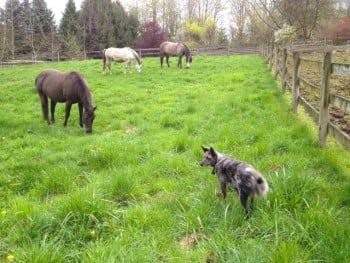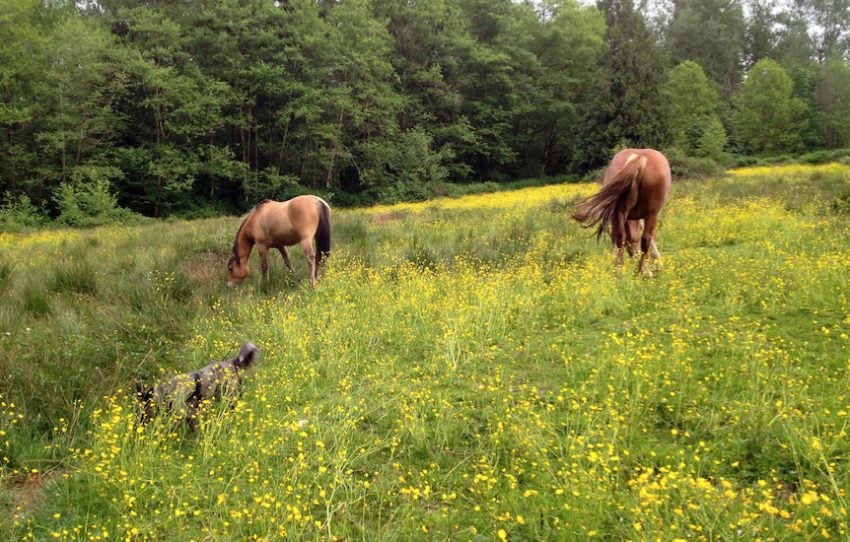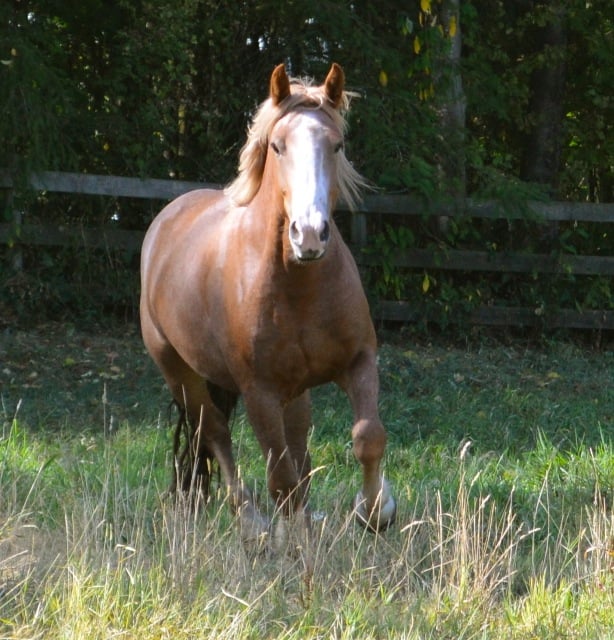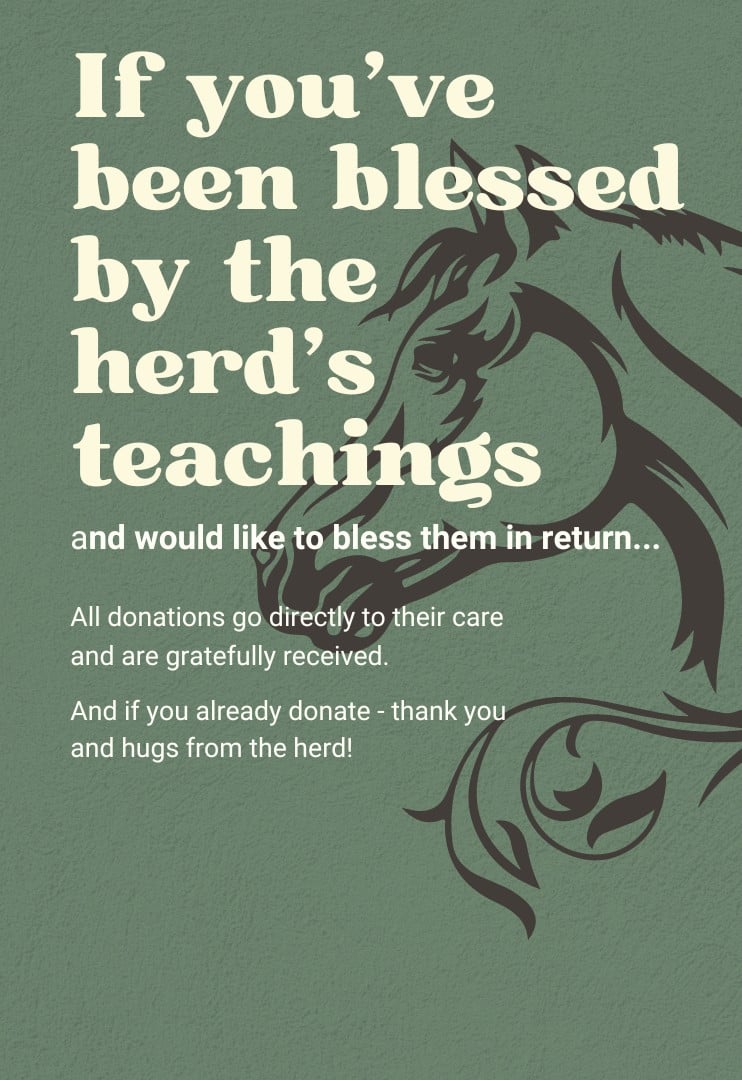
For our horses first boarding situation (see picture above), they had continual access to one grass field year-round, but by the Spring, there was a lot of manure in that field and not so much edible grass! So in April, we began letting them into the new, lush field that stood idle all year. We removed all manure and rotated the fields to prevent worm egg ingestion and allow the soil to recover in the trampled field – seeding as needed.
Here is the schedule we used, starting in April, until we turned them full-time onto the new field in June – but if your horse is really sensitive, then you may need to start at only 5 minutes per day:
Week 1: 15 minutes on grass per day
Week 2: 30 minutes of grass per day
Week 3: 45 minutes of grass per day
Weeks 4-5: 1 hour of grass per day
Weeks 6-9: 2-3 hours of grass per day
Throughout the summer we kept low sugar hay in the slow feeders for them – so they still had a choice about what/where they ate.
However, there are 2 schools of thought on leaving horses to graze on grass. The first, more common, opinion is supported by equine nutritionist Dr. Juliet Getty and focuses on the sugar content of the grass and minimizing your horse’s intake. Here’s Dr. Getty’s information on transitioning to grass in both Spring and Fall:
“Transitioning a horse from hay to pasture must be handled with care; this point is non-negotiable. For every horse, a gradual change from hay to grass is required to allow the digestive system to adapt, but for the insulin-resistant horse, grazing time and duration can make the difference between soundness and a disabling condition like laminitis. This time of year can be a test of patience for horse—and owner. The horse may be pawing at the gate to get to the first taste of tender spring grass, yet the owner must pay close attention to making the transition safe and healthful.
The first spring sprouts are actually lower in sugars and starch (non-structural carbohydrates—NSC) because they use all that energy to promote their own rapid growth. As the leaves form, the overall sugar and starch content increases, making it especially tempting. Regardless of the growth stage, quantities should be monitored because horses crave fresh grass and will eat volumes of it, making their overall NSC consumption really high—dangerously high for horses who are overweight, cushingoid, or who have experienced insulin-related laminitis.
Temperature and sunlight play a major role in the amount of NSC accumulation. To be safe, here are the rules:
· When the night temperature is below 40 degrees F, the grass is too high in NSC.
· Once it gets above 40 degrees F at night, the lowest NSC level is before the sun rises.
· The NSC level is highest in late afternoon, after a sunny day.There is no exact “best time” to turn out your horses on pasture. Generally speaking in moderate climates, it’s safest before dawn, until approximately 10:00 am, and then again at night, starting at around 11:00 pm. Start slowly, offering hay when horses are not on fresh grass.
Finally, test your pasture! Yes, testing is not only for hay. It will take the guesswork out of knowing which times are best.
But don’t think you’re out of the woods once spring is over. True, summer is safer, but as early fall nights cool down below 40 degrees F, the dangerous carbohydrates once again increase.
Grass accumulates NSC (sugars and starch) as it is exposed to sunlight. The levels reach a peak in the late afternoon. During the dark hours, the grass uses this fuel for itself, and by morning, the levels are at their lowest. But, cold nights prevent grass from using as much NSC, resulting in a higher NSC concentration during the day.
Don’t be fooled by the brown grass you see in the late fall. Spread it apart and you’ll likely see some green at the base, which is high in sugar and starch. If it hasn’t rained in a while, your grass will look dried out; but be careful – dry grass can actually have a higher NSC percentage than long, lush-looking grass.”
Grass is good
Now let’s look at another approach – even with easy-keepers like Drafts, a Fjord and Andalusian this is the method I prefer. This second approach to managing grass intake, yet facilitating 24/7 grazing is supported by the amazing barefoot trimmer Maureen Tierney:
“The requirements for safe transition are as follows:
The grass must be short – either from winter grazing or from being mowed The area must be around 1 acre per horse (at least in the beginning) The horses must be out on the pasture 24/7 without hay (at least in the beginning).
That is it. After the horses have been on the pasture they may (most will) start to lose weight. As they near their optimum weight, either pasture size can be increased some, or supplemental hay can be offered – not FULL hay diet, just some supplemental hay.
Recently I have read that slowing a horse’s food consumption rate can prevent or lessen insulin resistance (click here for link to article). And I have also read that being overweight CAUSES insulin resistance. This has been confirmed by a client of mine who had to send her mare to Purdue for an eye injury. They tested the mare when she arrived and she was IR. (She was fat – and not my client at the time.) She lost weight while she was there (still somewhat too fat) and was tested again before she left, where her numbers were much improved.
So grass is not poison, but pasture must be managed.
I can hear some of you saying “longer grass has less sugar, and is safer than shorter grass.” Yes, I have read that too. However, this is where science departs from logic. What people forget to consider is that SAMPLE SIZE is the same. So basically, to put it simply, 1 inch of short grass has more sugar than 1 inch of taller grass. See the disconnect? 20 inches of tall grass has a LOT more sugar (and calories) than 1 inch of short grass. So simple and yet no one seems to think of it. When the grass is short the horse must take literally countless small bites over the entire day to get enough food to live. When the grass is longer, the horse can, and does, just stuff itself.”
As Kesia can confirm in her most recent boarding location, “Although I hadn’t tried this purposefully before, I recently got my three’s weight down when boarding circumstances sort of replicated this by chance: If your field is bigger than 1 acre per horse, use electric to make it smaller. Mow it before turning them out, but leave them out 24/7 (see the Maureen Tierney article). Don’t feed hay until there really is nothing left. If you have enough room, just make another field of 1 acre per horse and mow that before moving them onto it. Repeat rotation as required. The shorter grass has more sugar, yes, but there is significantly LESS grass, therefore less sugar overall. My fatties were moved onto a field decimated by deer, a month later they are looking fabulous and have only just run out completely as the grass dries up. This way they get all the benefits of grazing without the huge intake.”
My own herd of four easy-keepers are currently boarded on 10 acres – but about 2 acres of that is forest and the rest is mostly inedible or noxious weeds, as you can see by the sheer volume of buttercups here:

So in these circumstances I am able to just leave them out on the entire field 24/7 plus I have low-sugar hay available in slow feeders and hay nets.
I think another important point to make is that if you are leaving your horse on a mowed, or largely inedible field and not providing supplemental or free-choice, low-sugar hay, then you also need to be regularly removing manure from that field to prevent the ingestion of worms as they graze.
Remember, horses will not eat where they crap – unless they are super hungry. So in a scenario where they don’t have the option of free-choice (ad-lib) low sugar hay, you want to make sure you are not inadvertently starving them and forcing them to consume feces-contaminated grass.
Weight fluctuation is normal!
One last point I’d like to make is that it is normal for horses to chub up in one season and slim down in another. For a purebred draft, like my Belgian, it is normal for her to look 100 lbs heavier after a rainfall (new grass growth) than she does 4 days later!
When I lived in Alberta – with lush fields every summer – my horses and ponies would get big and round during the summers and then slim down in the winter. Keeping yourself warm in -30 degrees Celsius uses up a lot of fat (stored energy). None of them ever got laminitis, foundered or even colicked.
In fact, I had never even heard of insulin issues until I came to British Columbia, where the grass is lush, rainforest grass and the horses are mostly schedule-fed (fed only 2-4 times per day) which seriously messes up their metabolism and damages their gut from the continual acid production on an empty stomach.
So I think the best approach is to just keep an eye on your horses and don’t panic at a bit of weight gain. If they’re moving well, their hooves are good, they have plenty of energy, they like to run or play, their bowel movements are fine and you’re feeding a good range of vitamins, minerals and probiotics – they’re probably okay!
It’s very easy for us humans to project our own food issues onto our animals, so we need to be alert for that and not get hung up on them looking slim and trim all the time.

Jini Patel Thompson is a natural health writer and Lazer Tapping instructor. She began riding at age 2 in Kenya, and got her first horse at age 8 in Alberta, and so continues a life-long journey and love affair with these amazing creatures.








